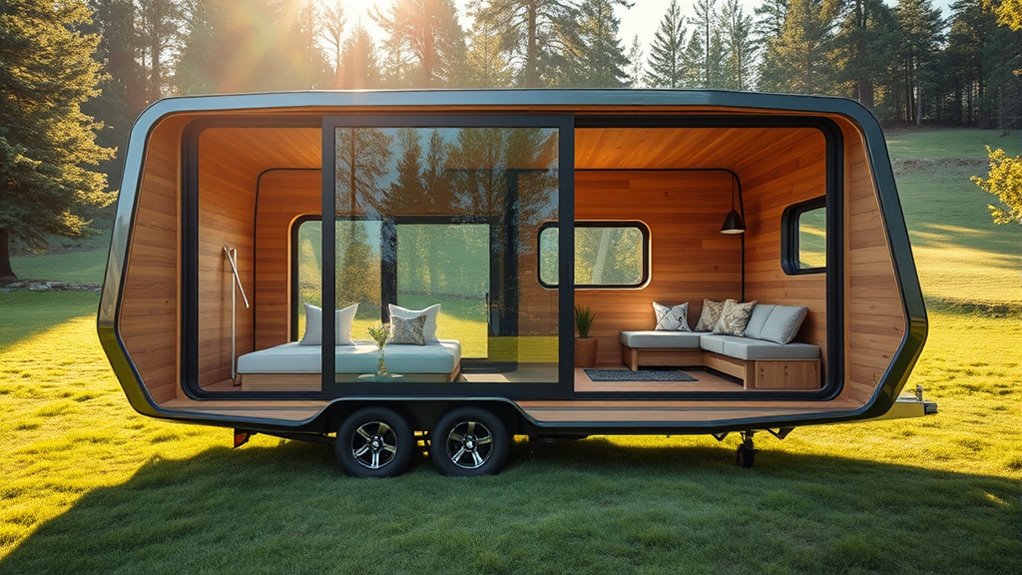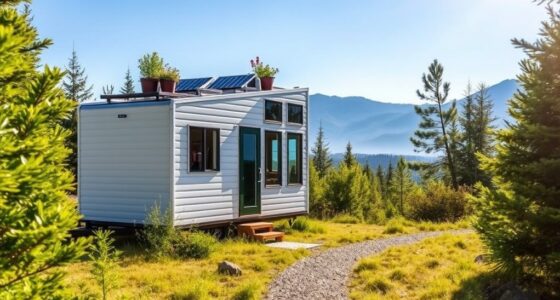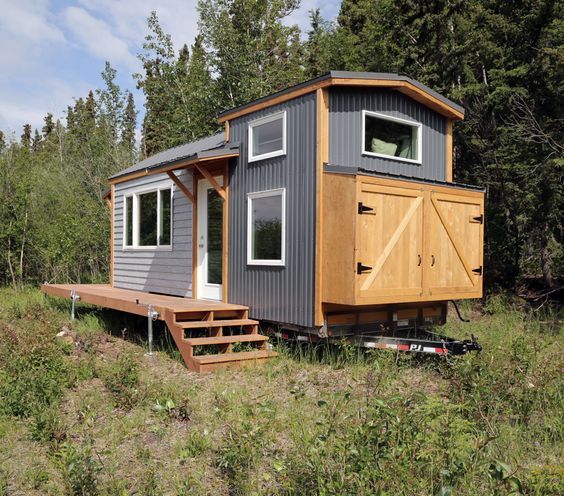When designing fold-out mobile tiny houses, focus on maximizing space with multifunctional furniture like fold-away beds and sliding walls to create distinct zones. Use lightweight, sustainable materials such as bamboo and reclaimed wood to keep the structure portable and eco-friendly. Incorporate built-in, collapsible storage and dynamic features that quickly transform your space for various needs. Paying attention to these strategies will help you craft a versatile, comfortable home that’s easy to transport and adapt, so stay tuned for more tips.
Key Takeaways
- Incorporate fold-out and retractable features for flexible space utilization and ease of mobility.
- Use lightweight, durable, eco-friendly materials to ensure portability and sustainability.
- Design multifunctional furniture that folds away to maximize open space during travel and living.
- Optimize vertical space with lofted beds and overhead storage to free up floor area.
- Implement collapsible partitions and sliding walls to create adaptable, distinct zones within limited space.

Have you ever wondered how to maximize small spaces for ultimate portability and comfort? When designing fold-out mobile tiny houses, space optimization becomes your best tool. These homes are all about making every square inch work for you, so you need clever solutions that allow for flexible living without sacrificing mobility. One of the key strategies is integrating multifunctional furniture and built-in storage that folds away neatly when not in use. For example, a bed that folds into the wall or transforms into a sofa can free up precious space during the day, giving you room to move around easily. Sliding walls or collapsible partitions can also help create distinct zones—kitchen, sleeping area, and workspace—without adding bulk. The goal is to keep the layout open and adaptable, so your tiny house feels spacious even when fully extended.
Incorporating sustainable materials into your design is equally important. Not only do these materials reduce your environmental impact, but they also often bring a sleek, modern aesthetic to your tiny home. Think bamboo flooring, recycled metal fixtures, and reclaimed wood accents. These choices contribute to a lighter, more portable structure while ensuring durability and eco-friendliness. When selecting materials for fold-out elements, prioritize lightweight options that won’t compromise the structural integrity or ease of movement. For instance, composite panels or engineered woods can be strong yet light, making them ideal for fold-out sections or retractable features. Using sustainable materials also aligns with the philosophy of minimalism and responsible living, helping you create a tiny house that’s both functional and environmentally conscious. Additionally, considering family dynamics and potential future needs can influence your design choices to ensure long-term comfort and adaptability.
Designing a fold-out tiny house demands careful planning to balance portability with comfort. You want to avoid clutter and complexity, so every design element should serve a purpose. Space optimization guides your choices, encouraging you to think vertically—adding lofted beds or overhead storage—and horizontally, by ensuring furniture and appliances can fold or slide away when not needed. Sustainable materials underpin these choices, making sure your tiny house remains lightweight, eco-friendly, and easy to transport. When you combine these principles, you end up with a home that’s not only highly functional but also aligned with sustainable living. Whether you’re living off-grid or just seeking a more mobile lifestyle, smart design choices will keep your fold-out tiny house comfortable, efficient, and ready to go whenever you are.
Frequently Asked Questions
What Are the Legal Regulations for Fold-Out Tiny Houses?
You need to check local zoning laws and building codes to understand the legal regulations for fold-out tiny houses. These rules vary by city and state, often dictating where you can park, set up, or live in your tiny home. Make sure your design complies with setbacks, height restrictions, and utility requirements. Consulting local authorities or a legal expert guarantees your fold-out tiny house meets all necessary regulations.
How Long Does It Take to Build a Fold-Out Tiny House?
Building a fold-out tiny house takes anywhere from a few weeks to several months, depending on your project’s complexity. Like assembling a puzzle, modular construction speeds up the process, offering design flexibility to suit your needs. If you choose a streamlined plan and work with experienced builders, you might finish in around 4-8 weeks. Patience and careful planning are key to creating your perfect mobile tiny home.
What Are the Insurance Requirements for Mobile Tiny Homes?
You need to obtain specific insurance policies for your mobile tiny home, including liability coverage to protect against accidents or damages. Insurance requirements vary by location and use, so check local regulations and consult with providers experienced in mobile home coverage. Make sure your policy covers theft, fire, and road accidents, giving you peace of mind while traveling or living in your fold-out tiny house.
Can Fold-Out Houses Be Customized for Disabilities?
Yes, fold-out houses can be customized for disabilities by incorporating adaptive design and accessibility features. You can include wider doorways, ramps, adjustable countertops, and grab bars to meet your specific needs. Working with designers experienced in accessibility guarantees your fold-out tiny home is both functional and comfortable. These modifications help create an inclusive living space that accommodates mobility challenges and enhances independence.
How Do Fold-Out Houses Perform in Extreme Weather Conditions?
Fold-out houses handle extreme weather reasonably well if designed properly. You’ll want to guarantee they have strong wind resistance features, like reinforced frames and secure locking mechanisms, to withstand high winds. Adequate insulation performance is also vital, as it keeps your home warm in cold weather and cool during heatwaves. Regular maintenance and choosing weather-resistant materials help these houses perform reliably, even in challenging conditions.
Conclusion
Think of your fold-out tiny house as a origami masterpiece, unfolding to reveal endless possibilities. With each clever fold, you create a space that’s as adaptable as a chameleon, blending comfort with portability. Just like a well-crafted paper crane, your design takes flight, offering freedom and flexibility in a compact form. Embrace this art of transformation, and your tiny house becomes not just a home, but a symbol of innovative living on the move.









